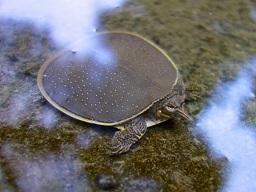Guadalupe Spiny Softshell Turtle (Apalone spinifera guadalupensis)
Description: Guadalupe's may lack the nasal septal ridge of other spinies. White tubercles surrounded by narrow black circles on the back 1/3 of the carapace, some tubercles can be quite large. It also may have some black dots spread out amongst the white tubercles.
Habitat: Its habitat includes rivers, ponds, streams, and lakes with a sandy or muddy bottom and relatively little vegetation.
Range: A relatively small range in southern Texas, consisting of the Nueces and Guadalupe/San Antonio drainage systems of south-central Texas.
Found in these States:
TX
Diet: The spiny softshell turtle will eat almost anything in the water that will fit into its mouth, which may include aquatic insects, crayfish, and the occasional fish. They will bury themselves under a layer of mud at the bottom of a lake, with only their head sticking out, and catch prey as it passes by.
Reproduction: In general, nesting occurs on high open sandbars and banks close to water.
Status: Because A. spinifera respire aquatically with pharyngeal gill slits and cloaca, they are vulnerable to Rotenone, a chemical that is used to kill unwanted fish. Rotenone hinders oxygen absorption and many soft shell turtles are now gone from Rotenone contaminated waters in the Great Lakes. Habitat fragmentation and shoreline development continues to threaten nesting sites. Along with other turtles, A. spinifera is hunted or shot for "fun" and human consumption. Eggs, hatchlings, and juveniles are threatened by various human activities and vulnerable to predators such as raccoons, foxes, and skunks, all of which thrive in areas of human development. They are not listed as endangered, vulnerable, or threatened by the IUCN, CITES, or the U.S. Endangered Species Act.
»» Kingdom: Animalia - Animals
»» Phylum: Chordata - Chordates
»» Subphylum: Vertebrata - Vertebrates
»» Class: Reptilia - Reptiles
»» Order: Testudines - Turtles & Tortoises
»» Family: Trionychidae - Softshell Turtle
»» Genus: Apalone
»» Species: Apalone spinifera - Spiny Softshell Turtle
»» Subspecies:
»» Guadalupe Spiny Softshell Turtle - ( Apalone spinifera guadalupensis)
This article uses material from the Wikipedia article "Guadalupe Spiny Softshell Turtle", which is released under the Creative Commons Attribution-Share-Alike License 3.0. Content may have been omitted from the original, but no content has been changed or extended.
|












